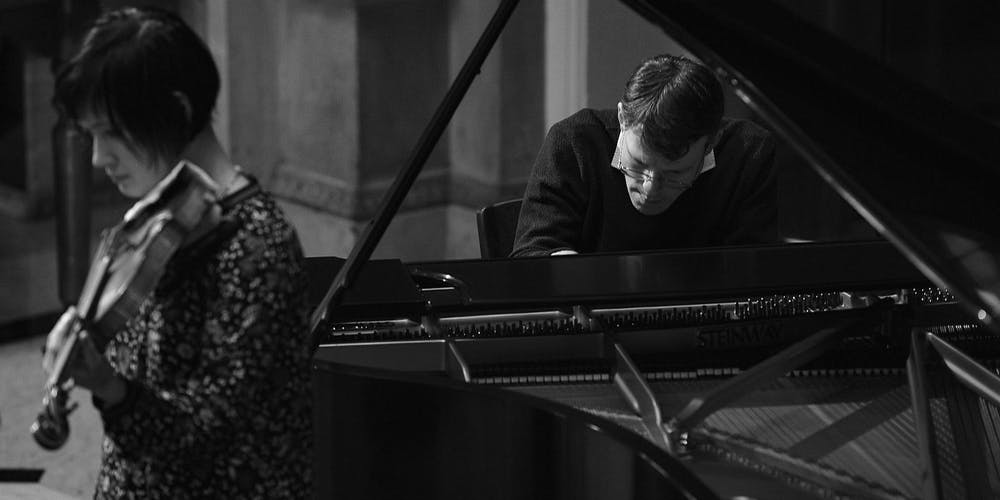Composer, Cuckson shine darkly, intensely in Hersch’s music for violin and piano

Michael Hersch and Miranda Cuckson performed Hersch’s music Tuesday night at National Sawdust.
It was Béla Bartók who titled one of his chamber works Contrasts. But the king of contrast in concert music today is surely Michael Hersch, as Tuesday night’s recital of his music at National Sawdust, by violinist Miranda Cuckson and the composer as pianist, vividly demonstrated.
In fact, if Hersch has musical heroes, Bartók, with his ferocious dissonances, is likely one of them. Another might be Messiaen, of the long thoughts and sensuous spirituality.
That Hersch can yoke together both of these aesthetics in one bar of volatile music is what gives his compositions their unmistakable identity. A texture of lamb’s wool leads to a punch in the face. Sounds attenuate to nothing, then well up like an ocean current. And Hersch’s integrity of imagination saves it all from sounding like cheap effects to shock the bourgeois.
It doesn’t hurt that Hersch is the ideal interpreter of his own piano music—gifted with an ear for luscious or luminous sonorities, and the digital technique to fling out dissonant torrents of notes that might have given Franz Liszt pause.
Violinist Cuckson, a longtime exponent of Hersch’s music, matched the composer for imagination and technical prowess, and contributed an eloquent and perceptive program essay besides.
The evening’s program did take a bit of explaining. Billed as excerpts from Hersch’s works for unaccompanied violin and solo piano, plus one piece for the two instruments together, the event came across as something quite different—a single continuous performance for violin and piano lasting a little over an hour, with an expressive arc all its own.
Cuckson’s essay, and a photograph of Hersch’s marvelously complicated handwritten chart, documented the process of pulling apart the brief movements of the original works—the weather and landscape are on our side, Fourteen Pieces, and Five Fragments for violin; The Vanishing Pavilions for piano; and the duo the wreckage of flowers. Some of the violin pieces were fitted with new piano parts, and assembling the 34 fragments into what was effectively a large new work, proved as unpredictable and yet convincing as a piano cycle by Schumann.
Along with the Schumannesque subjectivity went a childlike delight in the nature of the instruments themselves—the piano a box full of hammers, but with a damper pedal that can make chords last seemingly forever; the violin a smaller box with strings that you scratch with hair. The hiss and growl of “bow noise,” a no-no in your violin lessons, here became another color on the composer’s palette.
Still, for the most part, one was struck by how unradical the composer’s means were: no whacking the instruments or stuffing foreign objects in them, or looping them through electronics. The occasional twanging of a piano string or bowing sul ponticello sufficed.
In place of technical novelties there was a deep investigation of instrumental tone, Cuckson’s violin in particular ventured into many shades of pianissimo, often in the instrument’s most stratospheric range. Since all piano notes begin to die away as soon as they are struck, Hersch often had the violin do just the opposite—starting a note softly and swelling it suddenly and hard on an up-bow.
But for all the delight of musical invention, there was no question that Hersch’s music is serious business. Even without Cuckson’s essay tracing these pieces’ literary roots to the dark musings of Czeslaw Milosz, Primo Levi, and Bruno Schulz, one could hear the violence and desolation of world events in this century and the last echoing through the music’s wrenching contrasts and emotional probing.
In fact, it was a tribute to Michael Hersch’s fertile imagination that music of such unrelenting agitation—this composer doesn’t dance, and only rarely settles into a steady adagio pulse for a few bars—never tired the ear. As the glacial tread of No. 14 of the Fourteen Pieces brought the curtain down on the evening, one felt sorry to hear it end, and grateful for the opportunity to hear this remarkable music at length.
Nico Muhly & Friends present “’Marnie’ at the Met” 8 p.m. Sept. 27 at National Sawdust. nationalsawdust.org; 646-779-8455.